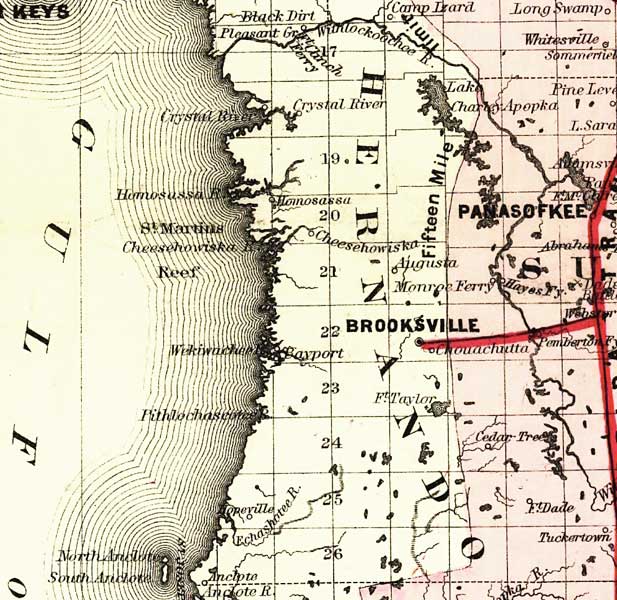The Hernando Preservation Society along with the Gulf Archaeology Research Institute (GARI) and the Seminole Tribe of Florida are undertaking a two-year archaeological study of the Chocochatti Seminole Village. Chocochatti is already a Florida Historical Landmark site with a marker on the truck bypass portion of Highway 50 a little east of Emerson Rd.
“Chocochatti is a very important historical-cultural resource for Hernando County, the State of Florida as a Florida Historic Landmark, and to the Seminole Tribe of Florida especially, since it is where their ethnogenesis from Creek to Seminole took place,” explained Jon Yeager, Hernando Historic Preservation Society member and former chairman of their Archeological Committee.
Yeager also stated, “The upcoming archaeological work by GARI (Gulf Archaeological Research Institute) and the STHPO (Seminole Tribal Historic Preservation Office) will shed more light on this transformation from Creek to Seminole. Another very important factor about Chocochatti will be a greater understanding of the Black Seminoles, who from records had a substantial presence in and around Chocochatti Prairie. The preservation society has been working toward this goal for many years now. Yet the story is still unfolding. Once archaeological work is complete, it would be the goal to preserve the area, to make an interpretive center with the Seminoles, so their story will be told, and Hernando County will benefit from such a situation.”
The Hernando Preservation Society welcomes any information, stories, artifacts, or history regarding Chocochatti. You can contact them and they will direct you to the appropriate person.
The name Chocochatti means “Red House” or “Red Town.” An early mention of the settlement was in A Concise Natural History of East and West Florida by Bernard Romans where he wrote “about the middle of the land, nearly in latitude 28, in a village called New Yufala, being a colony from Yufala, in the upper Creek nation, planted in 1767, in a beautiful and fertile plain.” Yufala or Eufaula was the name of the tribe that was a member of the Muscogee Creek Confederacy. The New Yufala settlement later became known as Chocochatti.
In 1836, the Seminoles of Chocochatti emigrated to the reservation in present-day Oklahoma during the early part of the Second Seminole War. They were led at the time by Fuche Luste Hadjo “Black Dirt.”
Chocochatti was not an English word so the spelling varies, it appears on maps with many different spellings. It appeared as Chicuchaty, Chicuchate, Chihuchaty, Chichuchate, Chichichate, Chicuhatte, Chocochattee, and Chocochatee among others.
Several Hernando County settlements lobbied in favor of the Armed Occupation Act, which granted land to settlers willing to move to the peninsula of Florida. Hernando County at the time included most of Pasco and Citrus counties. The settlement of Chuccochattee is mentioned in the petition dated December 1, 1842, “we the undersigned citizens inhabitants, of that portion of the Territory of Florida, known as the Chucochatee, Annuttaliga, and Homosassa settlements,” asks the President and Congress to “fulfil so much of the promise made us by the commander in Chief, as will enable us to prepare the lands we have selected under the new occupation law to Garner one crop—by granting a continuation of subsistence.” The list of signers is as follows:
Lloyd E. Dillon, E. J. Knight, E. T. Hart, Elisha Carter, Charles Goodrich, Hiram Parish, Jno A Bag, John OConnor, Michael Torney, Patrick McFeeley, F. Mathis, Wm Pennelton, R. Hall, Wm Cooley, George Rawls, Richard R. Crum, Joseph Moore, David B Turner, Sam L Moore, AJ Moore, Michael Shultz, Dennis Gill, John E Johnson, R W Clark, A. H. Morse, S T Branch, Rufus Hoyt, A H Crum, J. N. Garrison, W. M. Garrison, Robt. D. Bradley, William Hamby, Richard Wiggins Senr, Richard C. Wiggins Jr, Daniel Wiggins, Wm McKinney, David D. Crum, John Boyet, J Garrason, Henry Harn, Joshua Stafford, Richard L Garrison, Edward Boyet Sen, Edward Boyet Jun, James Baker, A. A. Baker, J. B. Baker, J. W. Baker, George W Davis, William Davis, John F Baker, James A. Boyet, Wm Taylor, James W Glendon, Thadeus L. Baker, Jacob Wells, William Hope, Jesse Carlisle, J. W. Riggs, W. W. Turkes, John B Allen
The records of the November 6, 1843 election from Hernando County report three precincts Chocochattee, Homosassa, and Toachadka. In that election, Isaac Garrason was elected Clerk of the County Court. The state legislature required that court be held at Garrason’s home at Chocochatee in 1844. In 1845, Isaac added becoming the first postmaster of Chocochattee to his resume.
Over time the settlement of Chocochatti faded away. There are few mentions of Chocochatti after the 1800s. The name was revived by historians culminating in the naming of Chocochatti Elementary School in Brooksville in 1999. In 2005, an archaeological discovery was made on Hope Hill located about 1.5 miles west of Chocochatti Prairie. Researchers from the University of South Florida, Toni Carrier, and Chris Bell, were conducting an excavation of William Hope’s home and discovered a “Seminole component,” as described by the Historic Hernando Preservation Society. (William Hope is a Hernando County pioneer.) Volunteers with Historic Hernando Preservation Society assisted Carrier and Bell with cleaning, categorizing and storing the artifacts found at the Hope Hill site in 2005. However, the preservation society states that further studies of these objects remain in order for “a complete picture to be ascertained of the region.” Hopefully, information garnered through past and upcoming archaeological endeavors will turn up interesting findings and perhaps one day there will be a visitors center that will provide information about the discoveries on Chocochatti.

